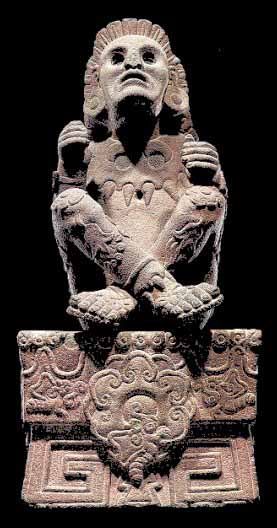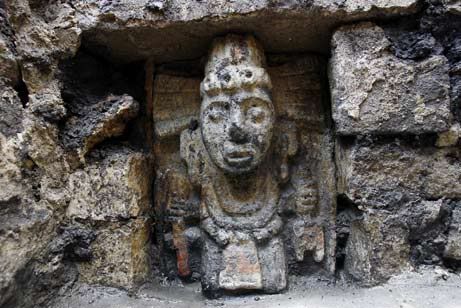Sunday, March 29, 2009
assignment 3C
Sunday, March 22, 2009
Assignment 3B Xochiquetzal Aztec Idol

In Aztec mythology, Xochiquetzal (IPA: [ʃotʃi'ketsal]) was a goddess associated with concepts of fertility and female sexual power, serving as a protector of young mothers and a patroness of pregnancy, childbirth, and the crafts practised by women such as weaving and embroidery. Unlike several other figures in the complex of Aztec female earth deities connected with agricultural and sexual fecundity, Xochiquetzal is always depicted as an alluring and youthful woman, richly attired and symbolically associated with vegetation and in particular flowers. By connotation, Xochiquetzal is also representative of human desire, pleasure, and excess, appearing also as patroness of prostitutes and artisans involved in the manufacture of luxury items. She was followed by a retinue consisting of birds and butterflies. Worshippers wore animal and flower masks at a festival, held in her honor every eight years. Her twin was Xochipilli and her husband was Tlaloc, until Tezcatlipoca kidnapped her and she was forced to marry him. At one point, she was also married to Centeotl and Ixotecuhtli. By Mixcoatl, she was the mother of Quetzalcoatl.
Monday, March 16, 2009
Assignment3A

Thursday, March 5, 2009
Assignment1C
Where is the MoLAA located? (www.molaa.com)
What is the MoLAA? (www.youtube.com first video)
Tuesday, March 3, 2009
Assingment 2B
What does MoLAA stand for?:
It stands for the Museum of Latin American Art
Explain what you see on the video clips:
i saw very distinctive sculptures that happen to me women and men of latin america, all the art looks very happy and there is nothing sad or gruesome about it, the women shown to be larger but their faces are very beautiful, these paintings and sculptures are very interesting and unique they keep you guessing on what the artist is trying to grasp in their work, its very abstract and unique
What did you learn from the video clips (3 facts)
* most of the paintings are very close to what happens in war and the history of latin america
*MoLAA presented a Latin American fashion show as a fund raiser for the museum
*MoLAA has over 800 pieces of art that are rotated with new collections every 6 months
Create 3 questions for your classmates based on the clips or websites
1) where is MoLAA located?
http://www.molaa.com/About-MOLAA/mission-and-history.aspx
2) Who founded MoLAA?
http://www.molaa.com/About-MOLAA/mission-and-history.aspx
3) What center was inaugurated as a venue to host public and private events and for the display of outdoor sculpture represented in the MOLAA Permanent Collection
http://www.molaa.com/Art/Exhibitions/Sculpture-Garden.aspx
List any 3 things you learned from the MoLAA website (be specific; give concrete answers for which your classmates can follow-up in upcoming assignments)
1)MOLAA's mission is to educate the public about contemporary Latin American fine art (by artists who have lived and worked in Latin America since WWII) through the presentation of a significant permanent collection, dynamic exhibitions and related cultural and educational programs.
2) Between 1913 and 1918 the site that the museum now occupies was the home of Balboa Amusement Producing Company, then the world’s most productive and innovative silent film studio
3)The Museum of Latin American Art (MOLAA) in Long Beach, California was founded by Dr. Robert Gumbiner in November 1996. It is the only museum in the western United States that exclusively features contemporary Latin American art.
Assignment 2A
Source (http://en.wikipedia.org/wiki/Interdisciplinary):
"Interdisciplinary studies" is an academic program or process seeking to synthesize broad perpectives, knowledge, skills, interconnections, and epistemology in an educational setting. Interdisciplinary programs may be founded in order to facilitate the study of subjects which have some coherence, but which cannot be adequately understood from a single disciplinary perspective (for example, women's studies or medivel studies). More rarely, and at a more advanced level, interdisciplinarity may itself become the focus of study, in a critique of institutionalized disciplines' ways of segmenting knowledge.
Source(http://www.schuelers.com/chaos/chaos9.htm)
Although no formal definition of interdisciplinary study has been widely accepted, if it is anything at all, it is a counter to the current fragmentation of knowledge that prevails in virtually all levels of our society today. Unlike the systems analysis approach of a team of experts, interdisciplinary study is an attempt to broaden the perspective of the individual scientist, researcher, educator, engineer, or social worker. Kleig (1990) gives four ways of defining interdisciplinarity: (1) by example, to describe the forms that it can take, (2) by motivation, to explain why it occurs, (3) by principles of interaction, to demonstrate the process of how various disciplines can interact, and (4) by terminological hierarchy, to use labels to distinguish various levels of integration. She acknowledges that these are all legitimate strategies.
According to Kleig (1990), interdisciplinarity implies an integration that can change or enrich each discipline. When disciplines are simply brought together in an additive fashion without integration or enrichment, it is called multidisciplinarity. She lists four kinds of interaction that can occur in the interdisciplinary process: (1) borrowing, (2) solving problems, (3) increased consistency of subjects or methods, and (4) the emergence of a new interdiscipline. At least one of these should be present.
B)
Source:(http://en.wikipedia.org/wiki/Latin_America)
In most common contemporary usage, Latin America refers only to those territories in the Americas where the Spanish or Portuguese languages prevail: Mexico, most of Central and South America, plus Cuba, the Dominican Republic, and Puerto Rico in the Caribbean
Source(http://www.answers.com/topic/latin-america)
Latin America the Spanish-speaking, Portuguese-speaking, and French-speaking countries (except Canada) of North America, South America, Central America, and the West Indies. The 20 republics are Argentina, Bolivia, Brazil, Chile, Colombia, Costa Rica, Cuba, Dominican Republic, Ecuador, El Salvador, Guatemala, Haiti, Honduras, Mexico, Nicaragua, Panama, Paraguay, Peru, Uruguay, and Venezuela. The term Latin America is also used to include Puerto Rico, the French West Indies, and other islands of the West Indies where a Romance tongue is spoken. Occasionally the term is used to include Belize, Guyana, French Guiana, and Suriname
C) Countries that make up "Latin America"
Argentina, Belize, Bolivia, Brazil,Caribbean, Chile, Colombia, Costa Rica, Ecuador, El Salvador, Falklands, French Guiana, Guatemala, Guiana, Honduras, Mexico, Nicaragua, Panama, Paraguay, Peru, South Georgia, Suriname, Uruguay, Venezuela
D) Countries that make up the "Carribean"
1. Anguilla
2. Antigua and Barbuda
3. Aruba
4. Bahamas
5. Barbados
6. British Virgin Islands
7. Cayman Islands
8. Cuba
9. Dominica
10. Dominican Republic
11. Grenada
12. Guadeloupe
13. Haiti
14. Jamaica
15. Martinique
16. Montserrat
17. Netherlands Antilles
18. Puerto Rico
19. Saint Kitts and Nevis
20. Saint Lucia
21. Saint Vincent and the Grenadines
22. Trinidad and Tobago
23. Turks and Caicos Islands
24. U. S. Virgin Islands
E) Cool facts that I learned about the Carribean and Latin America:
i learned that for the most part when the europeans took over, they brought over small pox and measels and wiped out a large proportion of the indigenous population, with epidemics of diseases reducing them sharply from their prior populations. Historians cannot determine the number of natives who died due to European diseases, but some put the figures as high as 85% and as low as 20%. i also learned that Latin is one of the most romantic languages in the history of our world.
F)Workcited
1)http://en.wikipedia.org/wiki/Latin_America
2)http://idrinfo.idrc.ca/Archive/ReportsINTRA/pdfs/v8n2e/109235.pdf
3)http://www.uis.unesco.org/profiles/EN/EDU/countries40314.html
4)http://www.schuelers.com/chaos/chaos9.htm
5)http://en.wikipedia.org/wiki/Interdisciplinary
D) Choose any two classmates and tell us what you have in common with that classmate:
Brittany hardison: we both work full time and take online classes
Marjorie V Crowder: we both are planning on going to sonoma state as well as majoring in accounting.
Assignment 1C
she currently works full time and takes classes online full time as well, she is taking her general education and hopes to become a registered nurse, she resides in pacifica, CA
What i learned from Brittany about Paulo Freire:
1)Although he was born into a middle class family his family was deeply impacted during the Great Depression. There were times during his childhood when his family would go hungry because there was not enough food.
2)In 1988 he was appointed the Minister of Education for the city of Sao Paulo which enable him reach and help many people.
Amanda Rossi:
she is currently a proud parent of a little girl name London, and she recently seperated from the military and is taking classes at Santa Rosa Junior College
What i learned from Amanda about Paulo Freire:
1)After college he married a woman by the name of Elza Maia Costa De Oliveira and had 5 children
2) He past away of heart failure May 2, 1997.